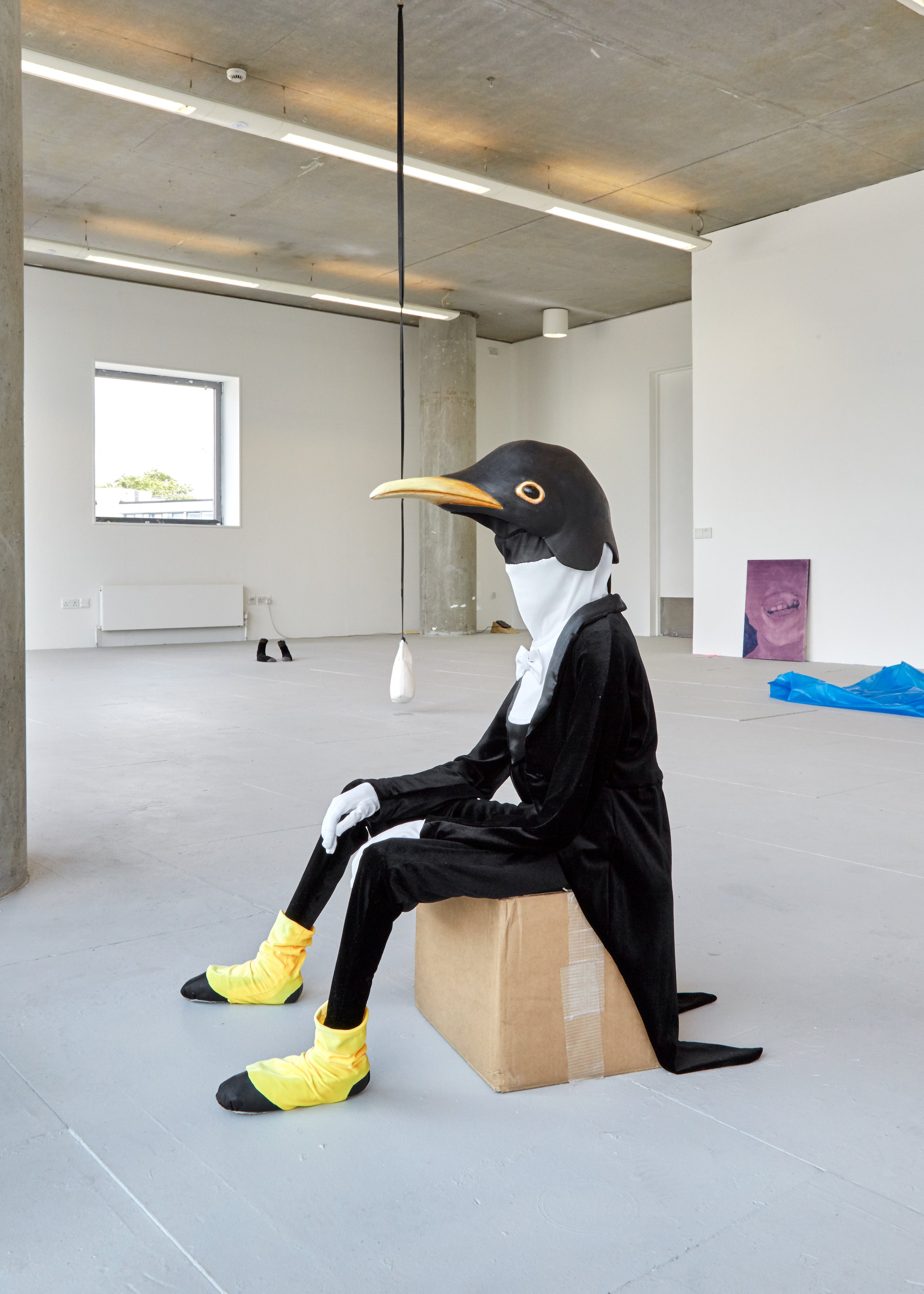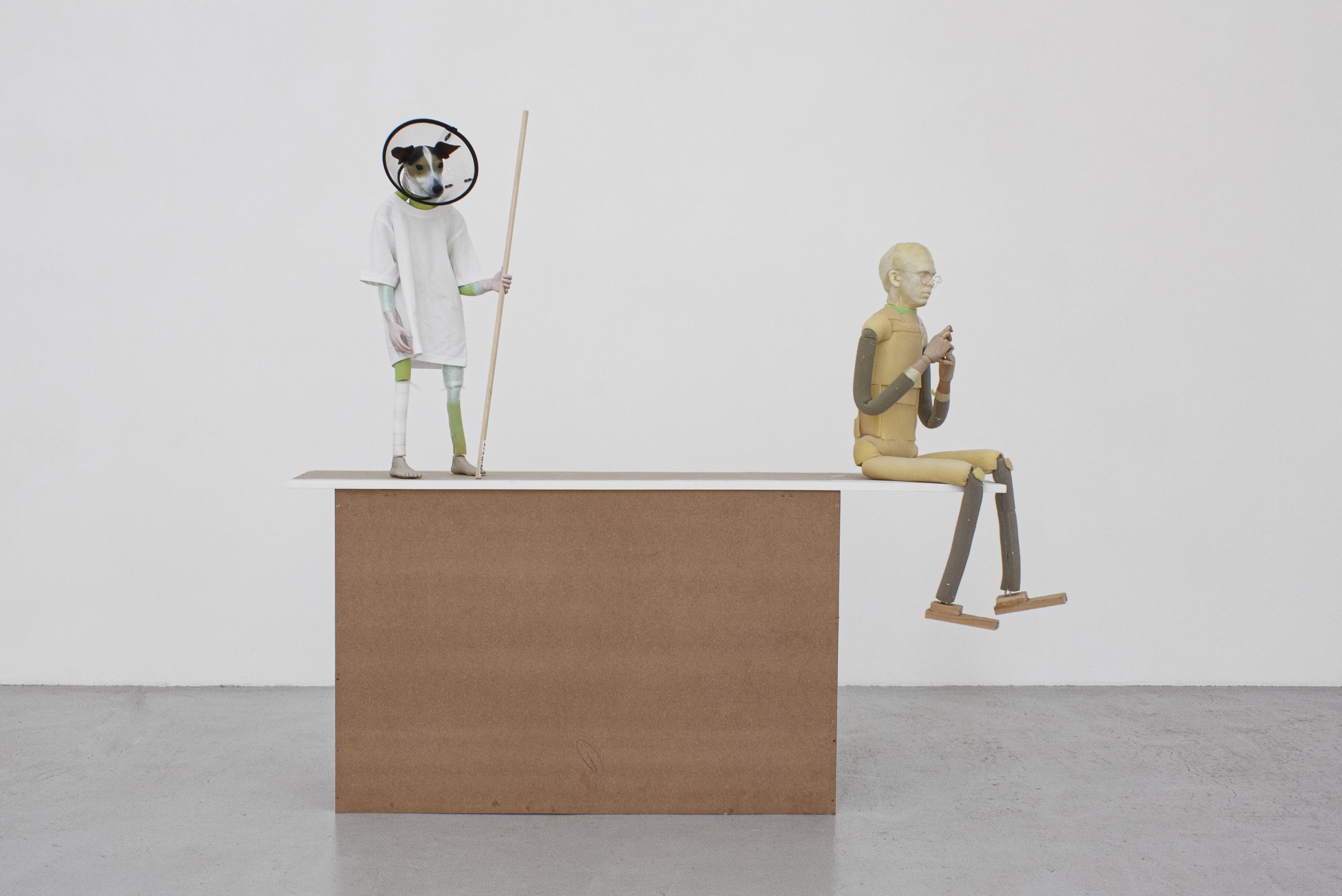Teal Griffin

"The figures often take the form of wanderers, or find themselves waiting, fixed in an in-between space. They are rather hapless, tragicomic, perhaps like characters from a Beckett play."
Could you tell us a bit about yourself and your background? Where did you study?
Sure. I was born, and grew up in Peckham, South-East London. Like many Londoners, my parents moved here from outside of the UK, and so we never had any immediate family on this island - they were all on the other side of the world. I think this probably affected my sense of place and belonging early on.
My old man worked in the theatre and film, as a stage and production designer. I have memories of running about film-sets and through the backrooms and bowels of theatres as a kid, and of the model-boxes in his studio, full of tiny scenes and furniture. These early encounters instilled in me a curiosity in scale, artifice and world-building - how the constructed can imitate life, and convey narrative.
I studied at Wimbledon for my Art Foundation, and then up to Newcastle for my BA Fine Art degree. After that I took some time out, moved back to London, then to Vancouver, travelled. In 2016 I returned to South London to do the MFA at Goldsmiths, which felt like studying in my back yard. I loved it.
Your work seems to capture moments frozen in time, creating a sense of both stillness and restlessness. Can you explain how you use a wide range of media and techniques to evoke these complex emotions and sensations in your art?
My work steps between and across sculpture, painting, video, text and spoken word. Although recently it seems to keep coming back to sculpture.
I like to think of my works as set-pieces. Space is important. The figures often take the form of wanderers, or find themselves waiting, fixed in an in-between space. They are rather hapless, tragicomic, perhaps like characters from a Beckett play.
The armatures I build reference those used in stop-motion animation, and thus have the kinetic potential of movement and pose-ability yet, without a hand to move them, remain static. I work with material intuitively; bodies are approximations, I use packing foam in a volumic way, and cable-tie it to wire frames and steel ball-jointed armatures - materials which typically function to protect vulnerable surfaces here come to signify the fragility of a living body.
I am fascinated with models. There is a provisionality to a model; it is a proposal or suggestion, which might indicate failure, but equally it implies the hope of something new. The masks and costumes I make are hand-carved and hand-sewn, finely detailed, which contrasts with the rudimentary bodies which are almost like maquettes’s. The differing affective potentials of material are crucial to choices that I make, for example the softness and plasticity of clay in contrast to the cold, hardness of steel.
Bardo, 2022
Bardo, 2022 (detail)
Tower, 2023
Trolley, 2020, photographer: Corey Bartle Sanderson
Waiter, 2018 photographer: Corey Bartle Sanderson
Your exploration of memory and the poetics of loss is quite evocative. Can you discuss how your personal experiences influence the themes and emotions that you aim to convey in your art?
Yes, my work can be self-reflexive - my own experiences are the only truths I know, and I am drawn to the potential of accessing the universal through the personal. My father died of lung cancer when I was twenty-five. Both grief, and the experience of witnessing the rapid degradation of his body whilst caring for him, had a lasting impact.
The melting of muscle paired with the certainty of an end. There is an ungraspable element to loss, to grief, the magnitude of its certainty is incomprehensible. And I think of that in relation to today, in which discussions of climate systems and habitats being in terminal decline feel omnipresent. How does one even begin to comprehend something like that?
I think a lot of my work is about the body; the fragility of a body, yet also its strength and resilience. Balance here is important, otherwise things just sink. Where there is heaviness to my work, it’s always through the lens of lightness; the dichotomy between humour and pathos.
The concept of objects becoming surrogates and fragments forming new wholes is intriguing. Could you elaborate on how you select and assemble these elements to create an atmosphere of contemplation and anxiety in your installations and assemblages?
I feel that, in the space of loss, language fails, something is shattered. I became interested in the idea of Bricolage, in which an entirely new whole is constructed from disparate parts. Maybe it’s a form of up-cycling or re-cycling, assemblage or something. I like the hopefulness in this.
There is also the overlap of the space of memory, which is inherently fragmented and connected to something no longer, yet continually remade and re-formed.
The penguin, for example, is borrowed from a costume design for a ballet from the 80’s that deals with climate catastrophe, in which each dancer and their dance represents a species endangered and displaced. I am interested in this continued displacement, this terminal from which we are still waiting. There is something absurd about a ballet character removed from the music that gives them purpose, and thus renders them still, and aimless.
I keep coming back to a quote by the Iranian poet and filmmaker Abbas Kiarostami which I think is nice: ‘The essence of poetry is a level of incomprehension. A poem, by its very nature, is unfinished and unfixed. It invites us to complete it, to fill in the blanks, to join the dots.’
A Mobile For Arya, 2021, Künstlerhaus, Bremen, photographer: Fred Dott
nail picker, 2020
Dock, 2020
Tell us a bit about how you spend your day / studio routine? What is your studio like?
I recently took on a new studio at Black Tower Projects, for which I feel very fortunate. Its a bit of a dream to be honest! Lovely big window. It takes a bit of time for me to bed in to a new space, a sort of nesting period, finding in what places things live, how to store things, its functionality, etc, as I’m painfully perfectionist, so I’m still finding my routine in some ways, but generally now feel settled in.
I try to get there as often as I can, whilst juggling time with freelance work. I’ll walk my dog Indigo there, throw her a chew stick, make a coffee and crack on the tunes. The great thing about the new place is that I have space to work on a few things at once, which for a practice like mine is really helpful.
What artwork have you seen recently that has resonated with you?
I thought that ‘Grenfell’ at the National Theatre was brilliant. Both forensic and affecting, in a way that emphasised the power of community through a diversity of testimony. It did this really interesting thing of flattening, in that rather a them and us relationship between audience and performers, it made things horizontal as the actors spoke to the audience as both themselves and as the real people/characters that they portrayed, which created this intense, yet warm atmosphere of sharing and witnessing.
The Martin Wong at Camden was worth the hype. I didn’t really know his work before, and I can’t stop thinking about the television screen made of bricks, the shop-front shutter paintings, nor the works he made up until the end of this life, always full of wit and dignity.
It was also a delight to see so many Alice Neel paintings in the flesh at the Barbican, even if the lighting was terrible.
Is there anything new and exciting in the pipeline you would like to tell us about?
Yes! I’m currently working on the sequel show to a collaboration I did with artist Charles Harrison. The original was called ‘Sandman Mattresses’ in which we made a pop-up mattress shop that looked as if it had always been there. I think some of the best feedback we got was of it being ‘both depressing and joyful’. There weren’t really any mattresses, but there was an animatronic pillow that breathed and we made a really mundane 1:2 scale office in the broom cupboard, including dead pot plant and a tea station.
The new show is called ‘Neptune’s Laundrette’ and it will open on the 26th October at Art Lacuna in Clapham, London, running for a month. I don’t want to give too much away, but it will feature a sound work: we are building a series, or chorus, of dryers and washers that perform and ‘sing’.
All images are courtesy of the artist
Date of publication: 16/10/2023







